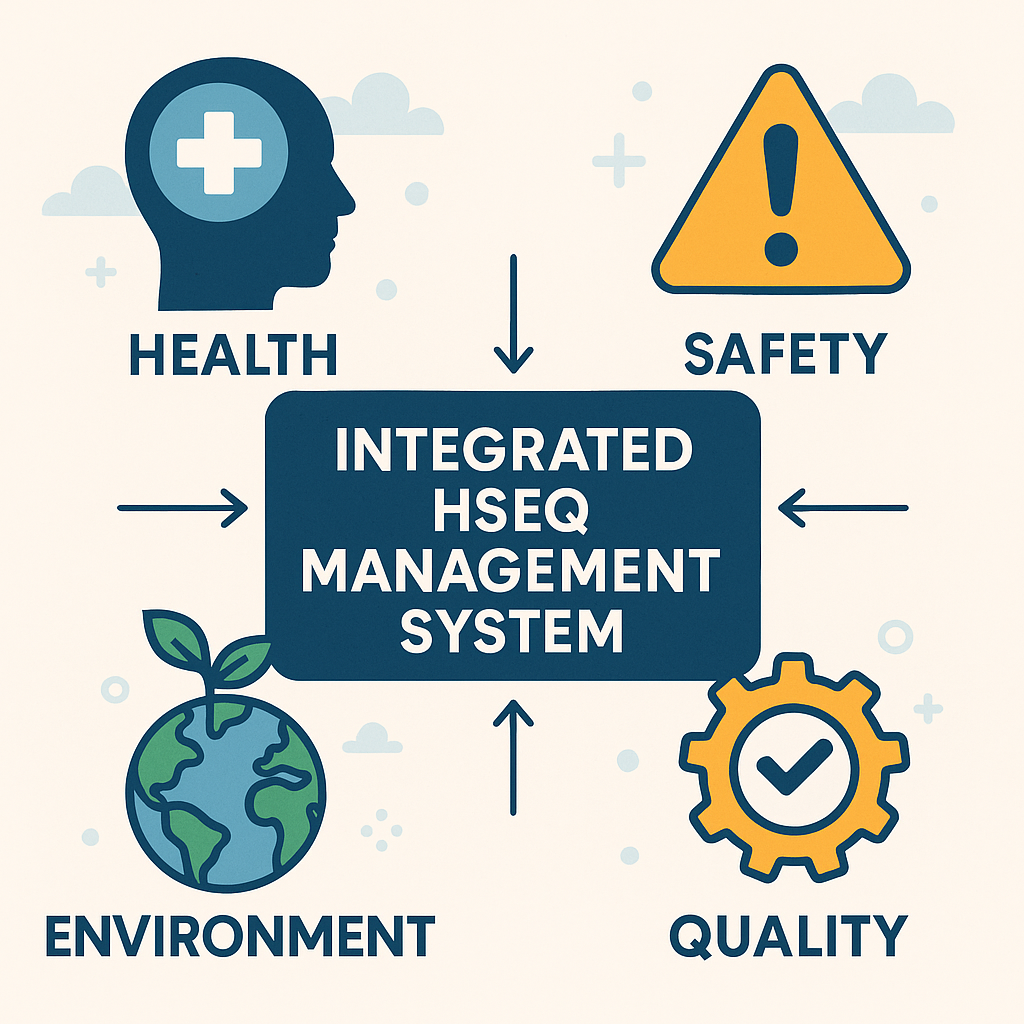An Integrated HSEQ Management System is no longer a luxury—it’s a necessity for any business that values long-term success, compliance, and a reputation for responsibility.
At the intersection of Health, Safety, Environment, and Quality, this unified approach to management allows organizations to streamline operations, reduce risks, and deliver consistent value to clients and stakeholders.

At the beginning of the 21st century, many organizations managed these four pillars separately. But with increasing complexity in regulations, customer expectations, and environmental pressures, a siloed approach is inefficient and prone to oversight.
This article explains why your business needs an integrated HSEQ system and how it can benefit you across multiple dimensions.
What Is an Integrated HSEQ Management System?
An Integrated HSEQ Management System brings together the standards and processes related to Occupational Health, Workplace Safety, Environmental Protection, and Quality Control under a single operational framework.
It aligns with international standards like:
- ISO 45001 for health and safety
- ISO 14001 for environmental management
- ISO 9001 for quality management
This integration helps businesses manage risks holistically and implement consistent procedures, while ensuring compliance with multiple regulatory bodies.
Benefits of an Integrated HSEQ Management System
1. Streamlined Compliance Across Multiple Standards
Managing HSEQ through a single system allows you to avoid redundant documentation and audits. You can address the requirements of multiple standards together, saving time and administrative overhead.
For instance, instead of preparing three separate audits for ISO 9001, ISO 14001, and ISO 45001, you can conduct a single integrated audit that satisfies them all.
2. Improved Risk Management
Integrated systems give businesses a comprehensive view of risk across health, safety, environment, and quality domains. By recognizing interrelated hazards, companies can apply proactive mitigation strategies.
Example: A food manufacturer might integrate hygiene (health), equipment handling (safety), packaging waste (environment), and product consistency (quality) into a single risk matrix.
3. Increased Operational Efficiency
Combining HSEQ efforts means shared responsibilities, unified training programs, and simplified reporting structures. This eliminates silos and allows your teams to work smarter, not harder.
Instead of running separate environmental and quality inspections, you can develop cross-functional checklists that address both in one go.
4. Better Employee Engagement and Culture
When your workforce understands that health, safety, quality, and environment are not separate concerns but part of a unified mission, it fosters a more consistent safety culture.
Employees feel more involved when there’s a clear, structured, and purpose-driven system in place.
Use of integrated digital dashboards for incident tracking and KPI reporting can further motivate teams and promote transparency.
5. Cost Reduction and Sustainability
Consolidating your HSEQ efforts can lead to significant cost savings through:
- Reduced duplication of audits and training
- Fewer workplace incidents and compensation claims
- Less waste and lower environmental compliance fines
- Improved product quality and reduced returns
Additionally, the system promotes sustainable operations that are aligned with ESG principles.
6. Competitive Advantage and Reputation
Clients, investors, and regulatory bodies prefer working with companies that are HSEQ-compliant and proactive. An integrated system allows you to demonstrate this in tenders, compliance reports, and marketing materials.
Being certified in ISO standards through a single integrated approach also enhances your corporate image and positions you as an industry leader.
Core Elements of a Successful HSEQ Management System
A fully functional Integrated HSEQ Management System includes:
- Unified HSEQ Policy Statement approved by top management
- Standardized Procedures for all departments
- Risk Assessments across all domains
- Training Modules aligned with integrated policies
- Incident Reporting System that logs health, safety, environmental, and quality events
- Performance Monitoring KPIs (e.g., LTIFR, environmental compliance scores, product defects)
- Audits & Continuous Improvement Plans following the PDCA Cycle
Industry Applications
An Integrated HSEQ System can be adapted to nearly any industry:
- Construction: Managing job site safety, dust/emission controls, and workmanship quality
- Maritime: Coordinating safety drills, pollution controls, and maintenance protocols
- Manufacturing: Linking process safety, energy use, and ISO compliance
- Healthcare: Combining infection control, workplace safety, patient experience, and waste management
Case Study Example
Company: Alpha Logistics Ltd.
Before integration, Alpha Logistics had separate safety, quality, and environmental departments. After adopting an integrated HSEQ system:
- Audit time reduced by 42%
- Incident reporting improved by 60%
- Customer complaints decreased by 25%
- Waste generation dropped by 15%
Their transition also helped them qualify for major international contracts due to ISO compliance.
- Read our article on What is HSEQ? – OHSE.ca
- Learn more about ISO Integrated Management Systems – ISO.org (DoFollow)
- See Confined Space Safety Guidelines – OHSE.ca
- Understand the PDCA Model – American Society for Quality (DoFollow)
- Find more HSEQ case studies at HSE.gov.uk
Final Thoughts on Integrated HSEQ Management Systems
Implementing an Integrated HSEQ Management System is one of the smartest moves a business can make. It not only simplifies your compliance efforts but also enhances efficiency, culture, and sustainability.
By viewing health, safety, environment, and quality as interconnected elements of success, your organization can gain a decisive edge in today’s competitive and regulated landscape.
Start building your Integrated HSEQ Management System today—and transform risk into opportunity.
Leave a Reply